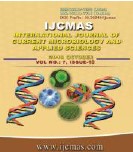


 National Academy of Agricultural Sciences (NAAS)
National Academy of Agricultural Sciences (NAAS)

|
PRINT ISSN : 2319-7692
Online ISSN : 2319-7706 Issues : 12 per year Publisher : Excellent Publishers Email : editorijcmas@gmail.com / submit@ijcmas.com Editor-in-chief: Dr.M.Prakash Index Copernicus ICV 2018: 95.39 NAAS RATING 2020: 5.38 |
Listeriosis caused by Listeria monocytogenes is an important foodborne infectious disease and is associated with severe diseases in humans and animals, prevalent worldwide. In the present study, a total of 1018 retail milk samples and 250 mastitic milk samples were collected from different districts of Punjab for isolation and molecular characterization of Listeria spp. The isolates were phenotypically and genotypically characterised by biochemical tests, in-vitro pathogenicity assay followed by detection of genus specific gene and different virulence-associated genes viz. hlyA, actA, iapA, plcA and prfA using PCR along with multiplex PCR for geno-serotyping of L. monocytogenes. A total of seven samples were found positive for Listeria spp by biochemical and molecular tests thereby resulting in an overall Listeria spp. prevalence of (0.68%) in retail milk samples. These seven Listeria isolates belonged to L. seeligeri (2 isolates) and L. grayi (5 isolates). Further, analysis of the results based on the zones revealed prevalence of 1.30% and 0.82% from the central plain zone and sub-mountain zone of Punjab, respectively. Taking into consideration the districts, then Ludhiana, Patiala, Tarantaran and Pathankot yielded 3%, 1.66%, 3.33%, and 3.33% prevalence of Listeria spp respectively. From the total 7 isolates varying degree of hemolysis was exhibited by the 2 isolates on SBA. The two isolates of L. seeligeri were haemolytic in nature. The remaining five isolates of L. grayi were non-haemolytic. All the seven isolates were not pathogenic based on in-vitro pathogenicity assay. None of the mastitic milk sample was positive for Listeria spp. Retail milk samples in our study meet the food safety guidelines of zero tolerance of L. monocytogenes, but the presence of other non-pathogenic Listeria spp require further scaling of hygiene measures during production, processing and retailing.
 |
 |
 |
 |
 |